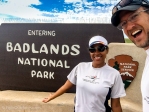
By Crystal Egli
WARNING:
This article contains images of open wounds and bare feet.


This is 24 hours after the initial wound, as I wanted to spare you from all the blood. You’re welcome.
After a 3.5 mile hike that ascended a 2,100′ elevation gain to land us at 11,371′, our camp site was finally in view. I surveyed the scene for a couple of trees to hang my Eno hammock between, and spotted Melanie waving at us up ahead. She had found a spot to camp and Brandon had gone ahead to claim it. “We’re going to have to cross this marsh, you might want to take off your shoes.” I removed my shoes and attempted to cross the marsh barefoot, but quickly turned back because the bottom of the waterway was riddled with extremely sharp broken off branches. Impossible for even the toughest of bare feet. Too cheap to replace my Tevas that broke years ago, I had only brought a pair of those $2 Old Navy Flip Flops with me. I unhitched them from the carabeaner on the outside of my pack and slipped them on my feet. This was the moment everything changed. Mid-way across the marsh, I slipped on a rock. Unknown to me, a sharp stone had found its way between my flip flop and my foot just before I slipped. As I caught myself, all my weight came down on the rock, and then my foot slid again the moment it hit the slippery flip flop. As I slid sideways the rock sliced a deep cut into the arch of my foot. Luckily, we had a first aid kit.
I don’t know if you’ve ever tried to bandage a wound on the bottom of your foot and then walk almost 4 miles, but it’s hard to keep a bandage ON. There is no way a simple band-aid would have stayed on, let alone held the wound closed as I walked, but lucky for us we had modified our first-aid kit. Buying one is a great start, but you really need to go through it and assess if the tools inside will actually work for a real-life medical need. As-is, there’s no way I could have bandaged my foot properly, so let me show you what we’ve added and how we made it work.
STEP 1: Applied antiseptic.

First Aid Kit
STEP 2: Applied a large band-aid.

Hiking First Aid
STEP 3: Secured band-aid with electrical tape. Electrical tape STAYS ON. I highly recommend adding it to your first aid kit. We have used it so many times.
STEP 4: Used scissors (or leatherman/knife/whatever you have) to cut the tape. You’re gonna need to bring something sharp with you as electrical tape doesn’t rip easy.

Hiking First Aid
And here’s the finish product, which stayed on without any problem until we got back to the car.

On that same trip, Melanie got a huge blister on the back of her heel which opened up into a gnarly open sore. The moleskin wouldn’t stay on alone, so Brandon used the electrical tape, again, to hold it in place. Back at the car it was still held perfectly in place, hours later.
And while hiking up to The Loch in RMNP, we helped bandage a random kid we found bleeding on the trail. Again, we used electrical tape to hold on the bandage, which in this case was gauze.

The Loch: Rocky Mountain National Park
So what else do we have in our first-aid kit in addition to bandages and electrical tape? Check it out.

We’ve used almost everything you see here, from the ace bandage to the tums. Let me break it down for you.
1. Small packets of generic pain reliever, antacid, antihistamine and non-asprin. We added to this as you can see at #11, because we go on longer trips and might need more than just a 1-day dosage.
2. Tongue depressors can be used to splint fingers.
3. In addition to supporting sprained appendages, we’ve used ace bandages to keep non-cooperative band aids in place.
4. I didn’t even realize we had these disposable tweezers until I took this picture. Examine your first-aid kits so you know what you have!
5. Medical tape. Totally useless on feet, but it can be used on other areas, and for making splints with the tongue depressors.
6. Antibiotic ointment. Even the smallest of wounds can easily get infected, so use it before applying bandages!
7. Moleskin – Have totally used this on blisters!!!! Don’t leave home without it.
8. We don’t really need these scissors because we always have a leatherman, but if you don’t regularly have a knife with you then keep these in the kit.
9. Large gauze pad for bigger wounds or to cover scrapes. Would keep on with the electrical tape.
10. Band-aids. So essential.

11. Larger quantities of allergy meds and a couple different pain relievers. I have used the allergy meds when I unknowingly ate someone else’s trail mix that had peanuts in it. I didn’t bring my epi pen, because I knew all my food was peanut-free, so I thought I was safe. But when my throat started to close 5 miles into the back-country, boy was I glad to have it with me (no one else did). Advil really helps with the altitude, so if you can take it, be sure to bring some for yourself and extra for others. Advil is actually the #1 thing I give out on the trail so I always bring a ton.
12. Anti-itch cream for rashes and bug bites. Definitely an essential.
13. (Not pictured.) Medical gloves, for when you end up treating strangers on the trail who didn’t think smart and pack their own first aid kit.
14. (Not pictured.) Electrical tape.

Hiking First Aid
Like a bike helmet, a first aid kit is something you always want to have with you but hopefully you will never have to use. Unlike a bike helmet, it turns out we’ve had to use it quite a lot, and not just on ourselves. You don’t need suitcase full of medical equipment, but you definitely need to bring something with you on every hike. Most of the times we’ve used the first aid kit were on day hikes in well populated areas! I highly recommend buying a small day-kit, and augmenting it by adding your own supplies and extra doses of personal medications such as the pain reliever of your choice.
Looking for a first aid kit? Here are some places you can grab one. (Click each one to open the link.)
A giant one from REI – Good for Car Camping
A variety of options from CampSaver.com
For those of you who are no stranger to first aid kits, what do you have in yours that I don’t have in mine? Anything unusual that you find yourself never leaving home without? Any first aid life hacks?
Happy (and safe) trails!
– C. Egli







Great set up! I always make sure to have an anti-diarrheal like Immodium in my kit. There is nothing worse than getting sick in the woods. I also carry Gatorade mix or electrolyte powder in the individual packets. Saved my hide when I overdid it on a hot day and forgot my food in the car. You might also consider a pair of nitrile gloves or a CPR sheild (both very lightweight), in case you need to help others on the trail. 🙂
LikeLike
Theses are great suggestions Martha! Adding an anti-diarrheal to our kit NOW. I always bring pedialyte in dry powder form but hadn’t considered it a “first aid” item before. I’ll throw a few extras in the kit. And good call on the gloves and shield– you never know out there. Thanks again for these great extras!
LikeLike